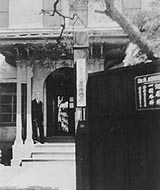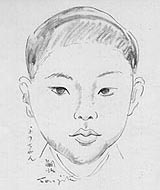| An Architect Looks Back By Ashihara Yoshinobu (Translated by Lynne E. Riggs. First published by Shinkenchiku-sha, Co., Ltd., Tokyo, 1985. All rights reserved)
Boyhood The house where I was born was in the Yotsuya section of Tokyo near a Buddhist temple called Sainenji. My father was born in 1868, the first year of the Meiji era and the year Japan began its ambitious efforts to modernize and westernize itself. He was reared in the countryside north of Kyoto near the Japan Sea. After finishing medical school in Japan he went to study medicine at the then German University of Breslau. When he returned to Japan after his sojourn abroad sporting a Kaiser mustache and telling stories of eating beef steak, I was told that it caused quite a stir in our household. Meat, as you may know, was not part of the Japanese diet until the Meiji era. Although eating meat became fashionable along with many other Western customs, it was still considered quite "barbaric" when my father was young.
Towards ArchitectureDuring the Sino-Japanese and Russo-Japanese wars, my father served as an army surgeon but then left the army to begin a general practice in Tokyo. He set up his clinic in the front rooms of our home and was devoted to his profession. I remember how dedicated and hardworking he was, and I also remember thinking even as a child that it was not a good thing to live in the same place where one worked. The front part of the house where I was born, the clinic, was Western style, a sort of pseudo-Palladian style of symmetrical design with double columns on either side of the front porch. It was quite a fashionable house with window sashes that moved up and down in the Western fashion, in contrast to the traditional window and door fixtures which all slid horizontally. The rear was Japanese style with quite a few rooms, stretching way back and surrounding an inner courtyard. At first, because I was the youngest of eight children, my room was at the very back. Later, when I began to study for the entrance examinations to middle school (age 13) my parents built a small study in the courtyard. My mother was the daughter of a surgeon major general of the army named Fujita Tsuguakira. The prominent novelist Mori Ogai (1862-1922), later the director of the Army Medical Corps, was a contemporary, slightly older, of my grandfather, but he had been educated at a national university, which placed him in a different social sphere from Fujita, who was educated at a private university. Grandfather Fujita had several daughters and every one married an army surgeon. His oldest son, Fujita Tsuguo, became a well-known scholar of constitutional law, and his second son was a Western-style painter, Foujita Leonard Tsuguji(1886-1968)*1 who lived in Paris. My mother was his oldest daughter. Uncle Tsuguji spent most of his life in France, and later told me that he had first made up his mind to go abroad when he saw my father, returned from Germany, brushing his Kaiser mustache. I had four brothers and three sisters. My eldest brother contracted tuberculosis and died rather young. Of the next three, all brothers, the elder two are businessmen; the third, Eiryo, was known as a ballet critic and connoisseur and collector of French chansons. We all went our separate ways, and none ever became a doctor, and though there were three girls in the family, none of them ever married a doctor. I guess the member of the family who had the greatest influence on me was Eiryo. He loved to study and was interested in almost everything. I remember he used to lecture me quite often, telling me I ought to study foreign languages and admonishing me to do as much as I could while still young. Most of my classmates at Tokyo First Middle School, like Kato Shuichi, the writer and literary critic, and Yanaihara Isaku, professor of philosophy and a man whose face inspired Alberto Giacometti, went on to the First Higher School. I studied for the entrance examinations with the same intent, but failed in two attempts. Finally I passed the examination for Seijo Higher School, a private school, and enrolled there. I had little interest in entering the family profession. What I wanted, I thought, lay somewhere between the extremes of art and science. I wanted to work hard when I worked, and be able to rest when the work was done. I did not like the idea of being subservient to a constant, unremitting grind. In university, therefore, I tried for architecture, and I was admitted. At that time war was fast approaching, however, and it was not really a time when one could lose himself in his studies. My father was anxious to have someone in the family inherit his practice, as is traditional in Japan, and initially he tried to convince each of his children to follow in his footsteps, but by the time it came to me, he had totally given up. He just said, "Yoshinobu, you do whatever you want to do." At the time, although there were many doctors in the family, there were no architects, but I entered the field undaunted. Now the family is filled with architects, including my own son. I remember very little of what I was taught at university. There was one professor of architectural history, Professor Fujishima Gaijiro, a man of very genteel manner, to whom I listened carefully. In class one day he said: "I'm really very glad I studied architecture. I can hardly describe to you the wonder I experienced when I climbed the Acropolis in Greece and saw the Parthenon." Thirty years later, I happened to meet Professor Fujishima and I told him that, and he said, "Oh, I remember you. I remember when you introduced yourself at the beginning of classes." (You would have to have been born before the war to know, but there was a well known fanatic then at the Matsuzawa Mental Hospital known as General Ashihara.) Anyway, I introduced myself to my classmates by saying, "There is the mad General Ashihara and there is the famous revue dancer Ashihara Kuniko; and there is me, Ashihara Yoshinobu, now beginning the study of architecture: we can all look forward to seeing how I turn out." He remembered that. Among my classmates there was Ikebe Kiyoshi and Tanaka Kazuhiko, both of whom later became professors at the University of Tokyo, but have since passed away. Then there was Yoshino Teruzo, who recently became President of the Shimizu Construction Company, one of the biggest construction companies in Japan. There were some other interesting characters, but my class and the class before me probably lost the most as a result of the war. *1. While best known internationally today as Leonard Tsuguharu Foujita, the name he adopted after World War II when he moved permanently to France and became a Christian, his relatives continued to call him Fujita Tsuguji, as he had been known earlier in his life. "Tsuguharu" is a variant reading of the same characters of his given name. |
|



